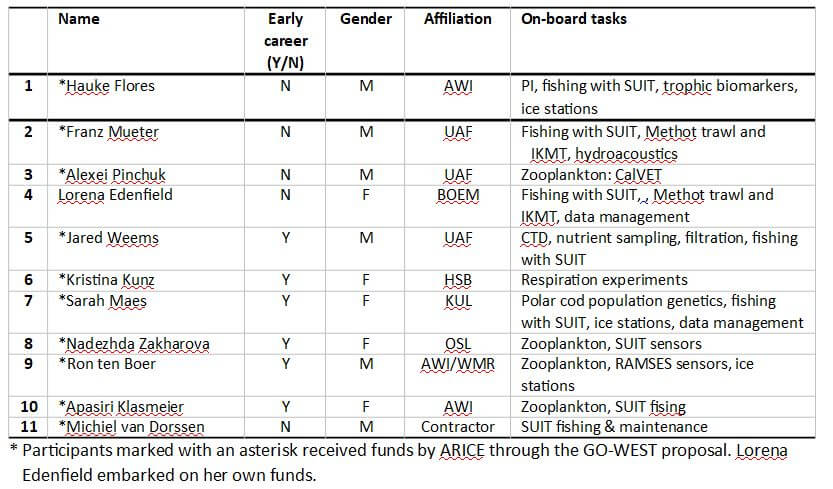GO-WEST, Beaufort Sea
Sea-ice association of polar cod and its prey in the western Arctic Ocean (GO-WEST)
Principal investigator: Dr. Hauke Flores, Alfred Wegener Institut, Germany

Proposal Partners: Dr. Franz Mueter, University of Alaska Fairbanks, USA
Prof. Dr.Filip Volckaert, Catholic University of Leuven (KUL), Belgium
Ms. Fokje Schaafsma, Wageningen Marine Research (WMR), Netherlands
Research Icebreaker: RV Sikuliaq (UAF-CFOS, USA)
Schedule: November 2019
Facebook or blog links: https://www.facebook.com/rvsikuliaq/
Abstract: Polar cod (Boreogadus saida) is a key fish species in Arctic marine ecosystems, because many Arctic birds and seals feed on this fish. However, polar cod may be particularly susceptible to sea-ice decline, because the young fish need sea ice as a shelter and a feeding ground. It has been proposed that parts of the population are entrained with the growing sea ice in autumn, but how this happens and what proportion of the population becomes stays with the sea ice is not known. Scientific studies using biomarkers have shown that young polar cod depend very much on biochemical compounds originating from algae growing within the sea ice (ice algae). The entrainment of young polar cod to the sea ice habitat during autumn may be a critical process in a sea-ice associated survival strategy of this species that is not at all understood. The overall goal of the proposed sampling is to test the hypothesis that many young polar cod in the Chukchi and Beaufort Seas are entrained into the sea-ice habitat during autumn, and hence sea-ice association is an important survival strategy with positive effects for the adult population. Sampling of polar cod and its prey in the ice-water interface layer combined with high resolution profiles of sea-ice properties will be combined with echosounder profiles to examine direct and indirect dependencies of polar cod populations on sea ice.

Summary of the Go-West Cruise
ARICE cruise acronym: Go-West
Full title: Sea-ice association of polar cod and its prey in the western Arctic Ocean
ARICE vessel involved: RV Sikuliaq
Implementation: together with the Coastal Ocean Dynamics in the Arctic (CODA)
Institutions & participants: seven institutions (plus contractor) and 11 on board participants

- AWI – Alfred Wegener Institute for Polar and Marine Research, Bremerhaven, Germany
- BOEM – Bureau of Ocean, Energy and Management, USA
- HSB – Hochschule Bremerhaven, Germany
- KUL – Catholic University of Leuven, Belgium
- OSL – Otto-Schmidt-Labor (AWI, AARI), Russia
- UAF – University of Alaska Fairbanks, USA
- WMR – Wageningen Marine Research, The Netherlands
The Goal:
The overall goal of the Go-West expedition was to test the hypothesis that entrainment of young Polar cod into the sea-ice habitat in the Chukchi and Beaufort seas during autumn is significant, and hence sea-ice association is an important survival strategy with positive effects on recruitment to the adult population the following summer. The main objectives of the collection of samples were to:
- Identify sea-ice habitats favorable for Polar cod in terms of physical properties, ice algal biomass and prey composition
- Test for the presence of deep scattering layers in the underlying water column
- Quantify the carbon flux between sea ice, plankton, and Polar cod and assess the pre-winter condition of Polar cod
- Study the connectivity between central Arctic under-ice populations and shelf-based spawning populations
Research and equipments:
During the expedition, samples of Polar cod and its prey were collected in the ice-water interface layer along with high resolution profiles of sea-ice and surface water properties with a Surface and Under-Ice Trawl (SUIT). Backscatter of fish and zooplankton in the water column was recorded with the Sikuliaq´s EK80 echosounder and pelagic communities was sampled with two midwater trawls (Methot trawl and IKMT) and vertical zooplankton nets (CalCET and ring net). A conductivity-temperature—depth probe equipped with a rosette water sampler (CTD) sampled vertical profiles of temperature, salinity and fluorescence and was used to collect water samples for the analysis for chlorophyll ɑ concentration, nutrient concentrations, trophic biomarkers and harmful algae (HAB). During four ice stations, samples of the sea ice for the same parameters (except nutrients) were performed with hyperspectral light measurements needed to derive ice algae biomass from hyperspectral profiles obtained from a sensor mounted on the SUIT. In addition, respiration measurements were performed on abundant zooplankton prey species of Polar cod. Altogether, 11 SUIT stations were completed (1 in open water, 10 under ice), 4 ice stations and 3 midwater trawls. All SUIT deployments were succesful, expanding Sikuliaq’s capability of advanced scientific operations in ice-covered waters. Polar cod were caught at all SUIT stations, totalling 153 fish.
Results:
The research indicate that most fish appeared to be first-year juveniles between 6 and 8 cm in size, pending age determinations. Fish abundance increased with increasing ocean depth, sea-ice draft and abundance of the ice amphipod Onisimus spp.. The mesozooplankton community in the upper 50 m was dominated by the copepod Metridia longa. Respiration experiments indicated that Metridia and, surprisingly, Calanus glacialis from shelf stations were in an active metabolic state. Chlorophyll ɑ concentrations were low (< 0.5 mg m-3) in the water column. Conversely, visual inspection of ice core filters indicated that ice algal biomass had already begun to accumulate in the autumn sea ice. The trophic relationships between ice algae, zooplankton and sea-ice fauna and Polar cod will be analyzed in detail based on hundreds of biological samples, including diet and trophic biomarker samples. Investigations of otolith microchemistry and population genetics studies on each sampled fish will help elucidate their origins and migration patterns. Preliminary results of this expedition support our hypothesis that juvenile Polar cod associate with sea ice in autumn and show that prey is available to sustain them at the onset of winter.
All samples collected during the expedition were listed in a central sample database and will be searchable through the ARICE dataportal and available for further research by request to the responsible scientist.
Photos, maps & graphs if available


